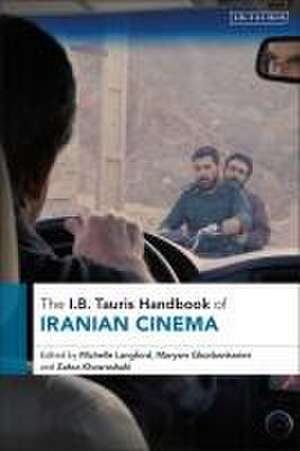The I.B.Tauris Handbook of Iranian Cinema: I B Tauris Handbooks
Editat de Michelle Langford, Maryam Ghorbankarimi, Zahra Khosroshahien Limba Engleză Hardback – 21 aug 2024
Preț: 683.85 lei
Preț vechi: 1202.19 lei
-43% Nou
Puncte Express: 1026
Preț estimativ în valută:
130.86€ • 136.90$ • 108.70£
130.86€ • 136.90$ • 108.70£
Carte disponibilă
Livrare economică 12-26 martie
Preluare comenzi: 021 569.72.76
Specificații
ISBN-13: 9780755648153
ISBN-10: 0755648153
Pagini: 480
Dimensiuni: 156 x 234 mm
Greutate: 0.95 kg
Editura: Bloomsbury Publishing
Colecția I.B.Tauris
Seria I B Tauris Handbooks
Locul publicării:London, United Kingdom
ISBN-10: 0755648153
Pagini: 480
Dimensiuni: 156 x 234 mm
Greutate: 0.95 kg
Editura: Bloomsbury Publishing
Colecția I.B.Tauris
Seria I B Tauris Handbooks
Locul publicării:London, United Kingdom
Caracteristici
Includes works both from pre- and post-revolutionary cinema, documentary and fiction, Art cinema and popular cinema, as well as contributions that draw on historical, socio-political and conceptual approaches. It also includes chapters that place Iranian cinema in transnational contexts
Notă biografică
Michelle Langford is Associate Professor of film studies at the University of New South Wales, Australia. Her research focuses on the cinemas of Iran and Germany. She is the author of Allegory in Iranian Cinema: The Aesthetics of Poetry and Resistance (2019) and has published on Iranian cinema in leading film studies journals including Camera Obscura, Screen and Screening the Past.Maryam Ghorbankarimi is Assistant Professor in film studies at Lancaster University, UK. She is the author of A Colourful Presence: The Evolution of Women's Representation in Iranian Cinema. Her edited volume on seminal Iranian filmmaker Rakhshan Banietemad, ReFocus: The Works of Rakhshan Banietemad was published in 2021. Her current research is on transnational cinema and culture, specifically the representation of gender and sexuality in Middle Eastern cinema.Zahra Khosroshahi is a postdoctoral fellow at the University of Toronto (SSHRC). She is currently working on her forthcoming monograph Iranian Women Filmmakers: A Cinema of Resistance. Zahra's research explores how film challenges systems of power, and how filmmaking specifically functions as a form of resistance in Iran. She completed her doctorate at the University of East Anglia, UK, working on prominent Iranian filmmaker Rakhshan Banietemad's cinema as a gateway into important discussions around gender, femininity, and the taboo.
Cuprins
Table of ContentsAcknowledgementList of FiguresNotes on ContributorsA Note on Transliteration and StylePart I: IntroductionChapter 1: Once Upon A Time in Iran by Michelle Langford, Maryam Ghorbankarimi, and Zahra KhosroshahiPart II: Production, Circulation and Reception of Iranian CinemaChapter 2: The Commercial Film Industry in the Islamic Revolution: Revisiting Narratives of Crisis and Collapse by Pedram Partovi (American University)Chapter 3: Cinema and Circulation in Iran: Continuities and Ruptures by Blake Atwood (American University of Beirut) and Mahsa Salamati (University of Sydney)Chapter 4: Making Stars in the Sky of Iranian Cinema Film Magazines and the Stars of Early Popular Cinema in Iran by Golbarg Rekabtalaei (Seton Hall University)Chapter 5: A Brief History of Film Criticism in Iran by Mohsen Azarm (Independent Researcher) and Hossein Eidizadeh (Independent Researcher)Chapter 6: Iranian Cinema and its French Audience by Asal Bagheri (CY Cergy Paris Université)Part III: Rethinking GenreChapter 7: Shocking Exchange: The Iranian Horror Film by Max Bledstein (University of New South Wales)Chapter 8: The War Must Go On: The Three Phases of Iranian Sacred Defence Cinema by Kaveh Abbasian (Kaveh Abbasian) Chapter 9: Mirrors of Childhood: Adaptation and Social Critique in Post-Revolutionary Iranian Child-Centred Cinema by Mazda Moradabbasi Fouladi (University of New South Wales)Chapter 10: Just 6.5: A New Modulation on the Social Issues Film by Anne Demy Geroe (Independent Researcher)Chapter 11: Tales of a City's Evolution: Tehran in Iranian Pre-revolution Cinema by Hamed Goharipour (The College of Wooster)Part IV: Transnational ExchangeChapter 12: Filmfarsi's transnational inception: techno-cultural exchanges with India and Egypt by Farshad Zahedi (Universidad Carlos III de Madrid)Chapter 13: Elusive Home, Elusive Time: What's the Time in Your World? By Nasrin Rahimieh (UC Irvine)Chapter 14: Shirin Neshat and Larissa Sansour: Transnational Stars, (Trans)regional Constellation by Lindsey Moore (Lancaster University)Chapter 15: Iranian Afghan cinema: towards a poetics of love and migration by Nina Khamsy (The Graduate Institute of International and Development Studies)Part V: Aesthetics of looking and listeningChapter 16: The Look at the Camera in Iranian Cinema before and after 1979: a Tropological Atlas by Matthias Wittmann (Johannes Gutenberg University Mainz)Chapter 17: Tehran City Symphonies: The Sounds of Conflicted Modernities, Silent Spaces and Highway Pleasures by Laudan Nooshin (City, University of London) and Kamyar Salavati (University of Exeter)Chapater 18: Silence and the Temporality of the Everyday: The Cinematic Modernism of Marva Nabili's The Sealed Soil (1978) by Rosa Holman (Independent Researcher) and Michelle Langford (University of New South Wales)Chapter 19: The Speaking Tree: The Mytho-poetics of The Female Voice in Bahram Beyzaie's Cinema by Farshid Kazemi (Simon Fraser University)Part VI: Visionary Women FilmmakersChapter 20: Gendering Documentary Film Industry in Iran: Independent Women Documentarians and Adaptive Strategies of Production by Najmeh Moradiyan-Rizi (Old Dominion University)Chapter 21: Women with Fighting Spirits: Transnational Documentaries by Kim Longinotto and Ziba Mir-Hosseini by Tania Ahmadi (Columbia University)Chapter 22: Transcending Stereotypes: Negotiating Motherhood in Rakhshan Banietemad's Cinema by Zahra Khosroshahi (Glasgow University)Chapter 23: Redefining 'Taboos': A feminist Reading of Ida Panahandeh's Titi (2020) by Maryam Ghorbankarmi (Lancaster University)FilmographyBibliography

